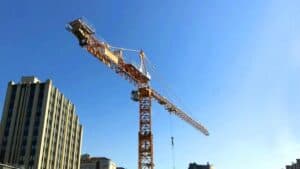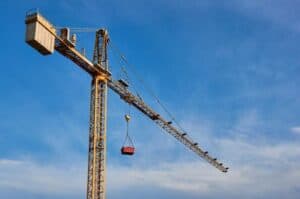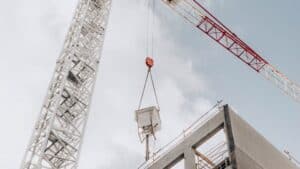Crane Terminology You Should Know Before Starting The Project – Glossary of Crane
IHURMO aims to demystify crane used terminology, providing clear explanations and insights into the language used in crane operations, maintenance, and safety protocols.
By familiarizing yourself with these specialized crane terms, you’ll be better equipped to communicate effectively in crane-related environments, improve workplace safety, and optimize crane operations.
Crane Terminology A

- Aerial Crane: A crane that operates in the air, typically a helicopter-mounted crane or a specialized flying crane.
- All Terrain Crane: Designed for versatility, these cranes can navigate and operate on various terrains.
- Auxiliary Hoist: A supplementary hoist system on a crane, often offering increased speed and lighter lifting capacity compared to the main hoist.
- Abnormal Operating Conditions: Environmental conditions that are unfavorable or harmful to the operation of a crane, such as extreme temperatures, corrosive atmospheres, excessive dust, moisture, or hazardous locations.
- Axial Load: The force acting along the axis of a crane’s structure, typically resulting from the weight of the crane itself plus any additional load it is lifting, which can produce either compression or tension.
Crane Terminology B
- Beaufort Scale (Beaufort Wind Force Scale): A scale used to measure wind speed and its corresponding effects on land and sea.
- Boom: A critical part of the crane, typically a long, extendable arm, is responsible for providing reach and leverage for lifting operations. See also “Jib.”
- Boom Truck Crane: A boom truck crane is a mobile crane mounted on a truck chassis featuring a telescopic or articulating boom that extends to lift and move heavy loads.
- Bridge: The structural element of an overhead crane that spans the work area, supporting the trolley and hoist.
- Bridge Travel: The movement of an overhead crane along the runway, enabling it to cover a larger work area.
- Ballast: Weight added to a crane’s base to enhance stability during lifting operations; it does not rotate when the crane swings.
- Beam: A horizontal structural element that supports loads and spans between supports, commonly used in crane systems to provide strength and stability.
- Brake: A device used to slow down or stop the motion of the crane, ensuring safe operation by controlling the descent of loads and preventing unintended movement.
Crane Terminology C
- CHAS: An industry accreditation body.
- Clearance: The safe distance maintained between a crane and any surrounding obstacles, ensuring operational safety.
- Conductors on Bridge/Runway: Electrical conductors that power the crane’s movements, positioned along the bridge or runway.
- Contract Lift: A specialized service where a company provides a complete lifting solution, including cranes, operators, and associated personnel.
- Controller: The component that regulates the flow of power to the crane’s motor, controlling its movements.
- Corrosion Resistant: Materials or coatings designed to prevent corrosion on crane components, ensuring longevity and reliability.
- Counterweight: Heavyweights are used to counterbalance the load being lifted by a crane, ensuring stability and preventing tipping.
- Crab: See “Trolley.”
- Crane: A mechanical device designed to lift and lower heavy loads, utilizing a system of cables, pulleys, and a power source.
- Crawler Crane: A crane mounted on a tracked undercarriage, providing excellent mobility on uneven or challenging terrains.
Crane Terminology D
- Drum: A cylindrical component around which the hoisting wire rope is wound, enabling the lifting and lowering of loads.
- Dead End: The end of a rope or chain opposite to where the load is applied.
- Dead Load: The weight of the crane itself or other permanent structural components, which remains constant during crane operation.
- Dock Crane: Located on docks, used for loading and unloading ship’s cargo.
Crane Terminology E
- Electric Overhead Travelling Crane (EOTC): An electrically powered crane that moves along a fixed overhead runway, commonly used in industrial settings.
- Emergency Stop: An emergency stop (E-stop) is a safety mechanism in industrial machines that immediately halts equipment operation during an emergency.
Crane Terminology F

- Floating Crane: A crane mounted on a barge or other floating platform, used for marine construction and other waterfront applications.
- Flange: A projecting edge or rim on a crane component, such as a wheel or beam, that provides strength and stability and allows for attachment to other parts.
- Feet Angle: The angle formed at the base of a crane’s support legs, which affects stability and load distribution.
- Friction Brake: A braking mechanism that slows or stops the movement of a crane by creating friction between brake pads and moving components.
- Fulcrum: The pivot point around which a crane’s boom or lever rotates, enabling the lifting and movement of loads.
Crane Terminology G
- Gantry Crane: A crane that operates on a fixed gantry structure, providing a stable platform for lifting operations.
- General Crane: A versatile crane suitable for a wide range of lifting tasks.
- Giant Cantilever Crane: A crane characterized by its large cantilever beam, offering extended reach and lifting capacity.
- Gross Load: The total weight of a load, including the item being lifted and all rigging equipment such as slings, shackles, and hooks
- Gear Box: A removable plate or panel provides access for maintenance or inspection purposes.
- Ground Conditions: The physical characteristics of the soil or terrain at a construction site, including factors such as soil type, bearing capacity, and underground features, which can affect construction activities and equipment stability.
Crane Terminology H
- Harbour Crane: A specialized crane designed for use in harbors and ports, handling cargo and supporting marine operations.
- Heavy Crane: A crane with a high lifting capacity designed for handling extremely heavy loads.
- Height of Lift (HOL): The vertical distance a crane’s hook can travel, measured from its lowest to highest point.
- Hoist: The mechanism responsible for lifting and lowering loads on a crane, typically consisting of a motor, drum, and wire rope.
- Hoist Rope: A hoist rope is a flexible steel cable made of twisted wires and strands wound around a core. It is designed for lifting and hoisting operations.
- Hoist Motion: The controlled movement of the hoist system for lifting and moving the load.
Crane Terminology I
- Indoor Use: Refers to equipment suitable for operation within enclosed spaces, such as factories and warehouses.
- Industrial Use: Lifting operations performed in industrial settings, often involving heavy machinery or materials.
- Insulation: Protective measures taken to shield crane components from extreme temperatures, moisture, and other environmental factors.
Crane Terminology J

- Jib: The horizontal arm of a crane that extends from the boom or tower, supporting the hoist and load block.
- Jib Length: The overall length of the jib influences the crane’s reach and lifting capacity at various radii.
- Joint: A crane joint refers to the connection point between two crane parts that enables movement and articulation, allowing the crane to perform functions such as slewing, telescoping, folding, knuckling, and luffing.
Crane Terminology K
- Kilo-Newton (kN): A unit of force commonly used to express the weight of loads in metric measurements.
Crane Terminology L
- Level Luffing Crane: This type of crane is designed to maintain the hook’s height while luffing (changing the jib angle), providing precise load positioning.
- Lift Angle: The angle formed between the hoist cable and a vertical line affects the crane’s lifting capacity at different radii.
- Lifting Capacity: The maximum weight a crane can safely lift, which varies depending on factors like the load’s position and the crane’s configuration.
- Lifting Range: The maximum horizontal distance a crane can move a load, often influenced by the boom length and jib extension.
- Load: The object being lifted or moved by the crane.
- Load Capacity: The maximum lifting weight of cranes.
- Load Block: A component at the end of the hoisting line that includes sheaves (pulleys) and a hook for attaching to the load.
- Load Line: The wire rope that connects the hoist drum to the load block is responsible for raising and lowering the load.
- Luff: The act of raising or lowering the jib of a crane to adjust the lifting radius and height.
- Luffer: See “Luffing-Jib Crane.”
- Luffing-Jib Crane: A crane equipped with a jib that can be luffed, allowing for flexibility in reaching loads at varying heights and distances.
Crane Terminology M
- Main Hoist: The primary hoist on a crane, typically capable of lifting the maximum rated load.
- Max Load: The absolute maximum weight a crane is designed to lift safely under ideal conditions.
- Max Radius with Max Load: The maximum horizontal distance a crane can safely lift its maximum rated load.
- Mechanical Handling: The use of machinery and equipment to move, lift, and manipulate materials efficiently.
- Meters Per Minute (MPM): A standard unit for measuring the speed of crane movements.
- MEWP: Mobile Elevating Work Platform. While not a crane, these platforms are used for work at height and include various types like boom lifts and scissor lifts.
- Mobile Crane: A crane mounted on a mobile platform, enabling transportation between job sites.
- Mobile Tower Crane: A tower crane with the ability to move around a job site, often featuring self-erecting capabilities for efficient setup.
- Mobility: The ease with which a crane can be moved and positioned is a crucial consideration for job site accessibility.
Crane Terminology N
- Night Working: Operations carried out during nighttime hours, often requiring specialized lighting and safety measures.
- Normal Working Load (NWL): Synonymous with “Safe Working Load.”
Crane Terminology O
- Outrigger: Extendable beams or supports used to increase a crane’s stability by widening its base, which is particularly important when lifting heavy loads.
- Overhead Travelling Crane (OTC): A crane that operates on a fixed overhead track or runway system, commonly found in factories and warehouses.
Crane Terminology P

- Point Load: A load concentrated at a single point, as opposed to being distributed over a larger area.
- Pulley Block: See “Load Block.”
Crane Terminology R
- Rated Load: See “Max Load.”
- Rough Terrain Crane: A mobile crane designed to navigate and operate on uneven or challenging ground conditions.
- Running Pulley/Sheave: A pulley that rotates freely on its axle, used to redirect the hoisting cable and reduce friction in a crane’s lifting system.
- Runway: A fixed track or beam system that supports and guides the movement of overhead cranes.
Crane Terminology S
- Safe Working Load (SWL): The maximum weight a crane can safely lift under normal operating conditions, considering factors like the crane’s configuration and the load’s position.
- SafeContractor: An industry accreditation scheme focused on health and safety practices.
- Setup Time: The duration required to prepare a crane for operation at a job site, including assembly, outrigger deployment, and safety checks.
- SSIP: Safety Schemes in Procurement, an industry accreditation body.
- Static Crane: A crane permanently installed in a fixed location that lacks the ability to move independently.
Crane Terminology T
- Telescopic Crane: A crane with a boom that extends and retracts telescopically, providing adaptability for various lifting heights and radii.
- Telescopic Handler Crane: A crane with a telescopic boom designed for both lifting and material handling tasks.
- Tower Crane: A crane characterized by its tall, vertical tower and horizontal jib, commonly used in construction for their height and reach capabilities.
- Trolley: The moving platform on an overhead crane that travels along the bridge, carrying the hoist and load block.
Crane Terminology W
- Working Load Limit (WLL): See “Safe Working Load.”
- Working Radius: The horizontal distance from the center of a crane’s rotation to the center of the load being lifted, a key factor influencing lifting capacity.
Crane Terminology Y
- Yoke: A yoke is an attachment for cranes designed to lift objects like wind turbine blades, containers, and man baskets.
This glossary provides a foundation for understanding common crane terminology. For specific technical information or if you have questions about crane selection and operation, consult with IHURMO. We are qualified professionals.
Frequently Asked Questions
What are the essential items to check during a pre-lift planning session?
You should check the crane’s load charts, ground conditions, and potential obstacles. Ensuring proper rigging equipment is crucial, as is confirming that all personnel are properly trained and briefed.
Could you explain what a critical lift is and when it applies to lifting operations?
A critical lift involves loads that are exceptionally heavy, complex or pose a higher risk. It usually requires meticulous planning, additional safety measures, and special permits to execute.
What basic lifting principles should all crane operators be familiar with?
Operators should know about load dynamics, the center of gravity, and the use of signal persons. Understanding the importance of balance and load distribution is also key.






